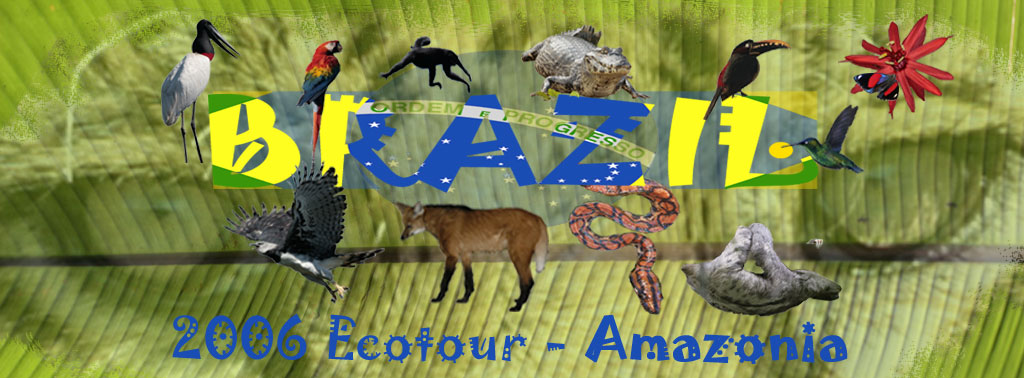



Added 3 September 2006
Day 16: Wednesday, June 21, 2006
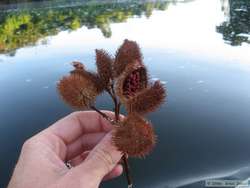
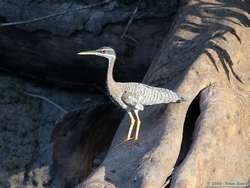 For our last morning at Rio Cristalino Jungle Lodge, Fabricio was able to wrangle us a boat for the morning, a fairly difficult task with the World Wildlife Fund film crew around, since they often use two boats, and therefore two guides/boat drivers. This time, we got Gilmar, so we managed to get all four of the Brazilian guides while there. According to Fabricio, this is quite unusual. Normally, each group has one Brazilian guide for their entire stay, and that they go with the group everywhere they go, even on hikes. This is better because it allows the guides to build a rapport with the guests, and also allows the guides to better share their knowledge of the forest, as they know what they've already told you and what they haven't.
For our last morning at Rio Cristalino Jungle Lodge, Fabricio was able to wrangle us a boat for the morning, a fairly difficult task with the World Wildlife Fund film crew around, since they often use two boats, and therefore two guides/boat drivers. This time, we got Gilmar, so we managed to get all four of the Brazilian guides while there. According to Fabricio, this is quite unusual. Normally, each group has one Brazilian guide for their entire stay, and that they go with the group everywhere they go, even on hikes. This is better because it allows the guides to build a rapport with the guests, and also allows the guides to better share their knowledge of the forest, as they know what they've already told you and what they haven't.
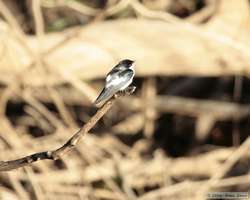
|
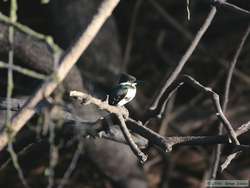
|
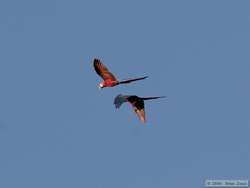
|
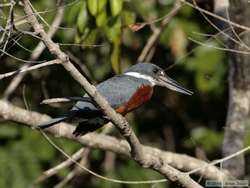
|
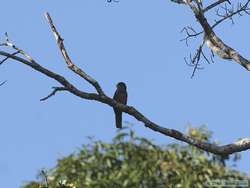
|
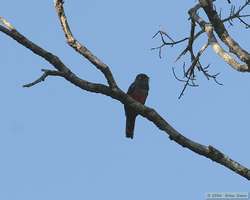
|
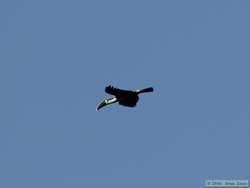
|
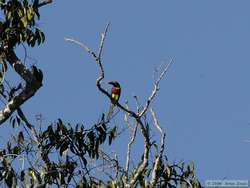
|
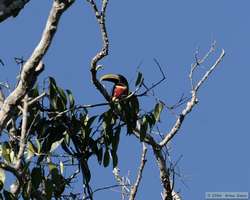
|
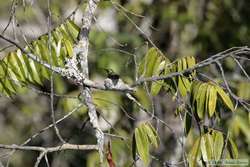
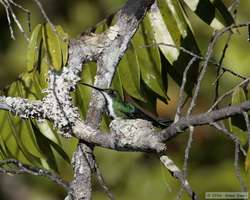 At any rate, we went down river for the first time, which was nice because we simply floated most of the way. That meant we were able to travel noiselessly, so we saw many birds, including quite a few new ones. We also got some great looks at birds we had seen before. Some of the highlights of the float were a nice look at a channel-billed toucan (Ramphastos vitellinus), a black-tailed trogon (Trogon melanurus), and a black-throated mango hummingbird (Anthracothorax nigricollis) on a nest.
At any rate, we went down river for the first time, which was nice because we simply floated most of the way. That meant we were able to travel noiselessly, so we saw many birds, including quite a few new ones. We also got some great looks at birds we had seen before. Some of the highlights of the float were a nice look at a channel-billed toucan (Ramphastos vitellinus), a black-tailed trogon (Trogon melanurus), and a black-throated mango hummingbird (Anthracothorax nigricollis) on a nest.
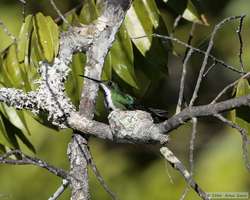
|

|
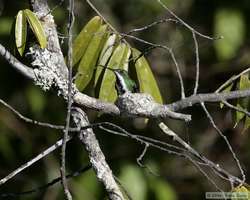
|
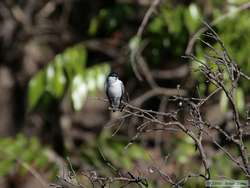
|
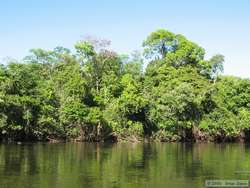
|
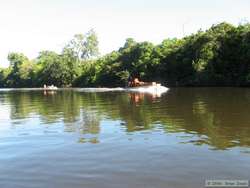
|
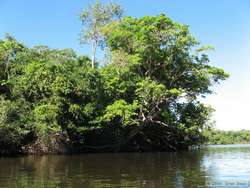
|
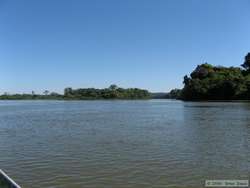
|
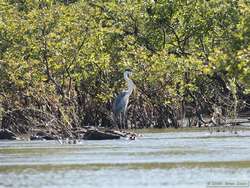
|
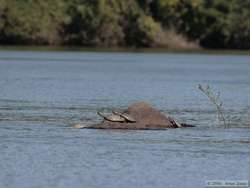 We floated all the way to the confluence of Rio Cristalino with Rio Teles Pires, then Gilmar powered us across the Teles Pires to an island that is owned by Vitoria. On the island, we got out of the boat to do a little more birding. On the island, we got a great look at a white-tailed trogon (Trogon viridis), and a pair of rufous-tailed jacamars (Galbula ruficauda).
We floated all the way to the confluence of Rio Cristalino with Rio Teles Pires, then Gilmar powered us across the Teles Pires to an island that is owned by Vitoria. On the island, we got out of the boat to do a little more birding. On the island, we got a great look at a white-tailed trogon (Trogon viridis), and a pair of rufous-tailed jacamars (Galbula ruficauda).
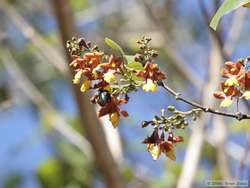
|
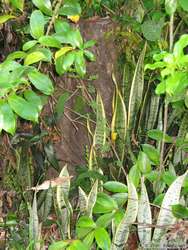
|
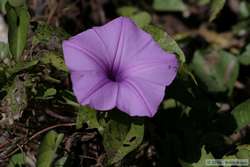
|
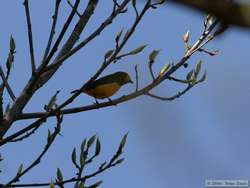
|
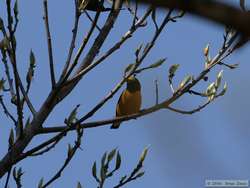
|
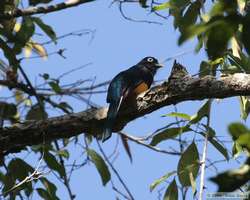
|
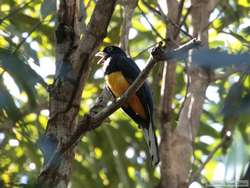
|
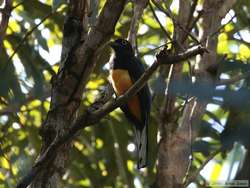
|
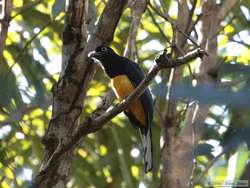
|
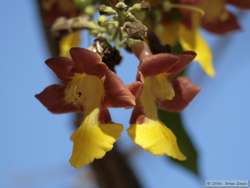
|
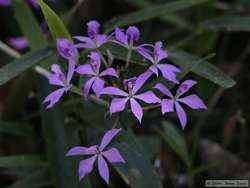
|
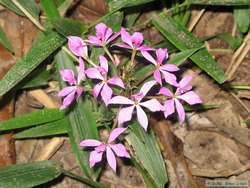
|
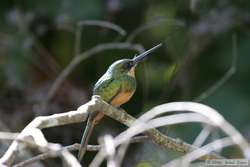
|
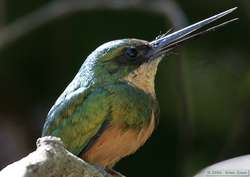
|
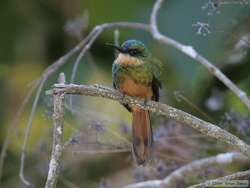
|
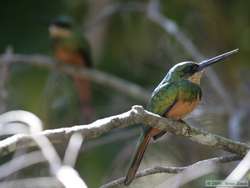
|
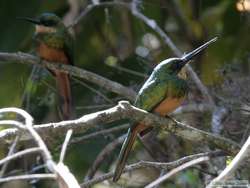
|
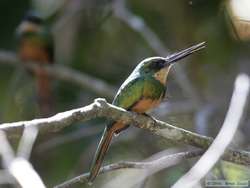
|
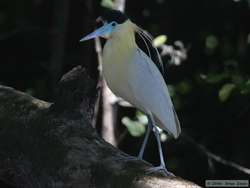
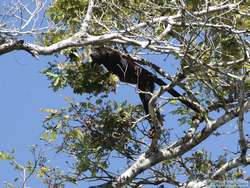 Then on the way back to the lodge, we got a good look at a brown howler monkey (Alouatta fusca). It was one of our best outings at Rio Cristalino, and a nice way to end our stay there.
Then on the way back to the lodge, we got a good look at a brown howler monkey (Alouatta fusca). It was one of our best outings at Rio Cristalino, and a nice way to end our stay there.
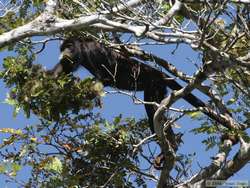
|
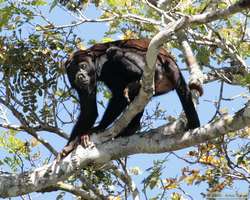
|
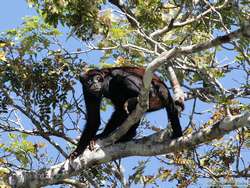
|
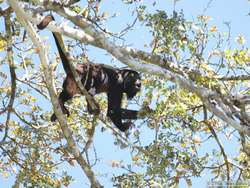
|
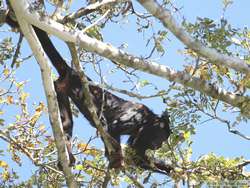
|
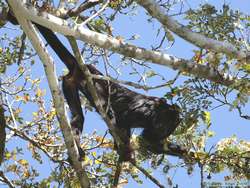
|
When we got back to the lodge, we gave Fabricio part of his tip. Earlier in the trip, we had noticed that for all the hiking Fabricio does, he only had tennis shoes to wear, and when we were in areas where there was potential for nasty things to crawl up your legs, all he could do was tuck his pant legs into his socks. 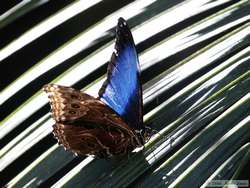 After some pointed questions, we learned that he would like a pair of boots, but didn't have any because they are really expensive in Brazil. My boots would have been far too big for him, but Shan's feet were pretty close to the size of his, so after our final boat ride, we gave him Shan's boots and gaiters, which seemed to fit him pretty well. I hope they serve him well.
After some pointed questions, we learned that he would like a pair of boots, but didn't have any because they are really expensive in Brazil. My boots would have been far too big for him, but Shan's feet were pretty close to the size of his, so after our final boat ride, we gave him Shan's boots and gaiters, which seemed to fit him pretty well. I hope they serve him well.
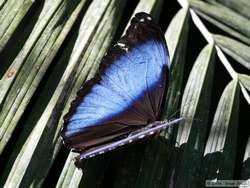 After that, we got organized and packed our stuff up to prepare for our imminent departure. Wanting to make the most out of my final hours at the lodge, I wandered around after lunch just to see what I could find.
After that, we got organized and packed our stuff up to prepare for our imminent departure. Wanting to make the most out of my final hours at the lodge, I wandered around after lunch just to see what I could find. 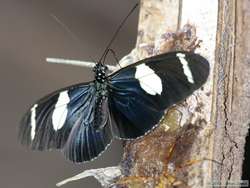
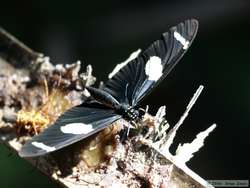 I didn't find much, but did see some new butterflies, and after returning to the lodge, found that Wil, who had re-caught the common cat-eye snake (Leptodeira annulatus), had chilled and released it.
I didn't find much, but did see some new butterflies, and after returning to the lodge, found that Wil, who had re-caught the common cat-eye snake (Leptodeira annulatus), had chilled and released it.
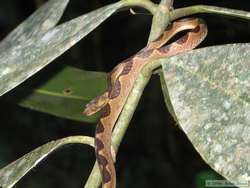 I arrived shortly before the film crew was done with it, so didn't have to wait long before being able to get some pictures of it. It didn't pose quite as nicely as the rainbow boa, and it was far less docile, so I didn't get as many nice shots, but I did get some good ones. I was also hindered by one of the women from the film crew, who stuck around to get some pictures on her own. While Wil, Amy and I were all conscious of staying out of each others shots and giving people room, she would just shove her camera in front of everyone else. More strikes against them, I'm afraid. Oh well, I know I saw far more even at Rio Cristalino than they did based on what I heard, so perhaps it's true, you get what you deserve. (And if I seem a bit snippy about the film crew, it is perhaps because I tend to have a low tolerance for inconsiderate people.)
I arrived shortly before the film crew was done with it, so didn't have to wait long before being able to get some pictures of it. It didn't pose quite as nicely as the rainbow boa, and it was far less docile, so I didn't get as many nice shots, but I did get some good ones. I was also hindered by one of the women from the film crew, who stuck around to get some pictures on her own. While Wil, Amy and I were all conscious of staying out of each others shots and giving people room, she would just shove her camera in front of everyone else. More strikes against them, I'm afraid. Oh well, I know I saw far more even at Rio Cristalino than they did based on what I heard, so perhaps it's true, you get what you deserve. (And if I seem a bit snippy about the film crew, it is perhaps because I tend to have a low tolerance for inconsiderate people.)
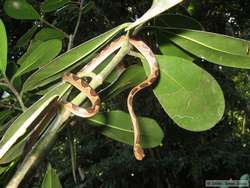
|
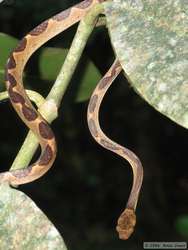
|
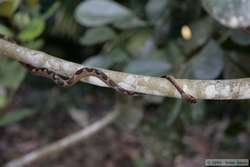
|
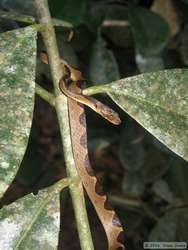
|
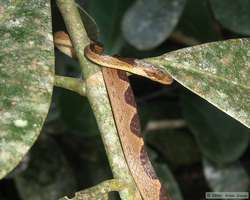
|
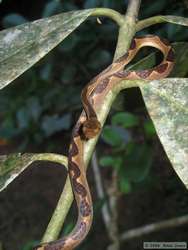
|
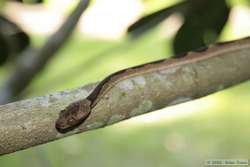
|
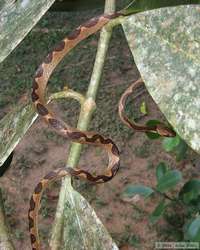
|
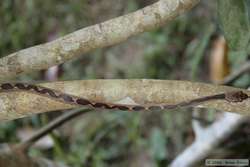
|
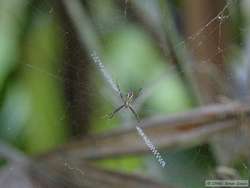
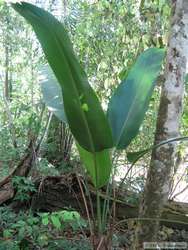 By the time the snake slithered off into the leaves and disappeared, it was after three o'clock, and time for me to find and tip the guides, gather up our luggage and get ready to leave. Our departure was delayed for a bit, so we sat and chatted with Jill, Amy and Tim (the guy who arrived on the boat that took Chuck and Dave home). I also showed Jill and Amy some of the pictures from our trip, including my jaguar pictures, and my river otter pictures, both of which really impressed Jill. She was pretty amazed at how lucky we had gotten on our trip.
By the time the snake slithered off into the leaves and disappeared, it was after three o'clock, and time for me to find and tip the guides, gather up our luggage and get ready to leave. Our departure was delayed for a bit, so we sat and chatted with Jill, Amy and Tim (the guy who arrived on the boat that took Chuck and Dave home). I also showed Jill and Amy some of the pictures from our trip, including my jaguar pictures, and my river otter pictures, both of which really impressed Jill. She was pretty amazed at how lucky we had gotten on our trip.
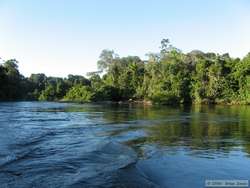
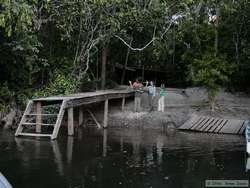 At around four o'clock, it was finally time for us to leave. Leaving with us were Tim, and a guy named Vincent, a Frenchman who I had scarcely even noticed at the lodge. We hugged good-bye to Jill and Amy, then shoved off and slowly motored down river. I spent much of the time talking to Tim, largely about binoculars and other optics.
At around four o'clock, it was finally time for us to leave. Leaving with us were Tim, and a guy named Vincent, a Frenchman who I had scarcely even noticed at the lodge. We hugged good-bye to Jill and Amy, then shoved off and slowly motored down river. I spent much of the time talking to Tim, largely about binoculars and other optics.
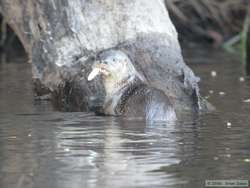 As we were talking, we were interrupted by an encore performance by a river otter (Lutra longicaudis). He kept swimming around and popping his head above water to look at us. Then while we were there watching him, he caught a fish, climbed up on a partially submerged log and ate it. The light was bad, but I took pictures anyway, and managed some passably decent shots. As I was watching it, I kept imagining what Jill would have said about our good luck.
As we were talking, we were interrupted by an encore performance by a river otter (Lutra longicaudis). He kept swimming around and popping his head above water to look at us. Then while we were there watching him, he caught a fish, climbed up on a partially submerged log and ate it. The light was bad, but I took pictures anyway, and managed some passably decent shots. As I was watching it, I kept imagining what Jill would have said about our good luck.
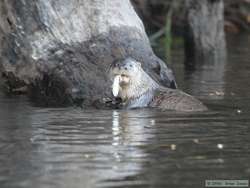
|
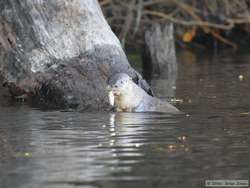
|
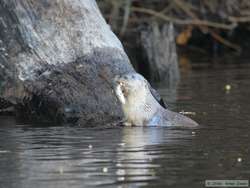
|
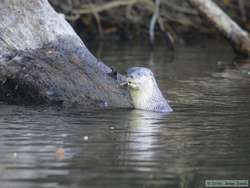
|
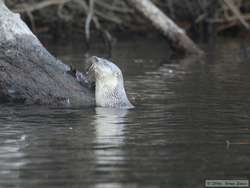
|
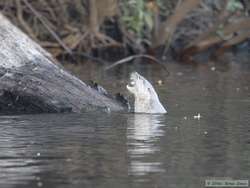
|
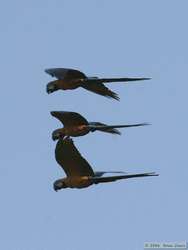
|
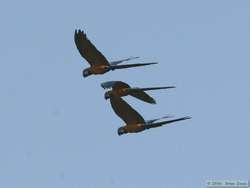
|
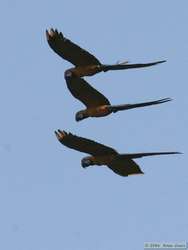
|
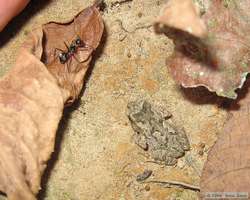 At the end of our boat journey, we loaded up the Land Rover and headed back to the Hotel Floresta Amazonica, where we would spend the next two nights. (Fabricio was successful in switching our last night at the jungle lodge for a night at the hotel in town.) We had dinner at the hotel, then retired for the evening.
At the end of our boat journey, we loaded up the Land Rover and headed back to the Hotel Floresta Amazonica, where we would spend the next two nights. (Fabricio was successful in switching our last night at the jungle lodge for a night at the hotel in town.) We had dinner at the hotel, then retired for the evening.
Species list for the day (46 birds, 2 mammals, 2 reptiles):
Anhinga (Anhinga anhinga)
Capped Heron (Pilherodius pileatus)
Cocoi Heron (Ardea cocoi)
Striated Heron (Butorides striatus)
Rufescent Tiger-Heron (Tigrisoma lineatum)
Black Vulture (Coragyps atratus)
Lesser Yellow-headed Vulture (Cathartes burrovianus)
Bat Falcon (Falco rufigularis)
Red-throated Piping-Guan (Pipile cujubi)
Sunbittern (Eurypyga helias)
Plumbeous Pigeon (Columba plumbea)
Scarlet Macaw (Ara macao)
Blue-and-yellow Macaw (Ara ararauna)
Blue-winged Macaw (Ara maracana)
White-eyed Parakeet (Aratinga leucophthalmus)
Painted Parakeet (Pyrrhura picta)
White-bellied Parrot (Pionites leucogaster)
Blue-headed Parrot (Pionus menstruus)
Black-throated Mango (Anthracothorax nigricollis)
Black-bellied Thorntail (Popelairia langsdorffi)
Gould's Jewelfront (Polyplancta aurescens)
Black-tailed Trogon (Trogon melanurus)
White-tailed Trogon (Trogon viridis)
Blue-crowned Trogon (Trogon curucui)
Ringed Kingfisher (Ceryle torquata)
Amazon Kingfisher (Chloroceryle amazona)
Green Kingfisher (Chloroceryle americana)
Rufous-tailed Jacamar (Galbula ruficauda)
Paradise Jacamar (Galbula dea)
Black-fronted Nunbird (Monasa nigrifrons)
Red-necked Araçari (Pteroglossus bitorquatus)
Channel-billed Toucan (Ramphastos vitellinus)
Band-tailed Antbird (Hypocnemoides maculicauda)
Screaming Piha (Lipaugus vociferans)
Amazonian Umbrellabird (Cephalopterus ornatus)
Stripe-necked Tody-Tyrant (Hemitriccus striaticollis)
Tropical Kingbird (Tyrannus melancholicus)
Social Flycatcher (Myiozetetes similis)
White-winged Swallow (Tachycineta albiventer)
White-banded Swallow (Atticora fasciata)
So. Rough-winged Swallow (Stelgidopteryx ruficollis)
Palm Tanager (Thraupis palmarum)
Purple-throated Euphonia (Euphonia chlorotica)
Swallow-Tanager (Tersina viridis)
Red-capped Cardinal (Paroaria gularis)
Para' Oropendola (Psarocolius bifasciatus)
E Brown Howler (Alouatta fusca)
Southern River Otter (Lutra longicaudis )
South American River Turtle (Podocnemis spp. )
Cat-eyed Snake (Leptodeira annulatus)
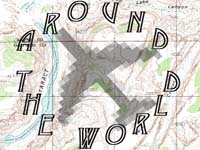 |
 |